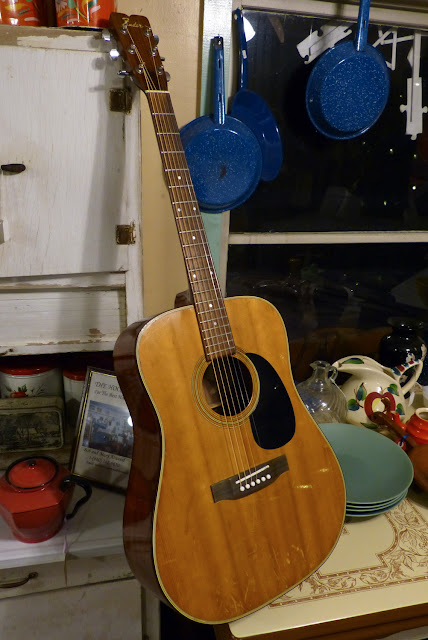1970s Fender F-35 Dreadnought Guitar
This guitar lacks its original label on the interior and so I had to do a bit of digging to get closer to its origins. I expected it to be from around 1980 and made in Japan (or Korea, maybe), but bouncing around on the net yielded the information I was looking for -- it's probably a late-70s F-35 and was, not surprisingly, made in Japan.
The original owner brought this in for some repairs and it got a new bridge, new saddle, fret level/dress, a free parts-bin tuner upgrade, a K&K pickup install, and general setup. For an all-plywood guitar, it does sound pretty good under the pick, and like other Japanese makes from the time (read: Yamahas) it's lightweight and loud. I have to be honest, here, and say that for many singer-folks a guitar of this caliber is a perfect general-use companion as the sound and feel is good (neck shape is like a 70s Martin) and the laminate build means it's tough.
The finish has lots of love bits and scratches.
The "dip" headstock is kind of funny but the truss cover is nicely restrained on this one compared to later examples which have Fender scrawled on them.
The fretboard is ho-hum rosewood but at least it's a solid slab rather than the ply rosewood one finds on many bound-board Japanese instruments from the mid-70s.
The original bridge (a stained-black rosewood one) was split with a hairline along the pins and so the owner had me install a new one. I'll say it -- gluing bridges on ply-top guitars is a headache. Often the first layer of laminate has peeled up or off with the original bridge's deterioration and then one has to solve that problem as well.
The ply guitars of this period are also braced fairly light (which is why they sound good) but that also means the top gets a "bump" under the bridge from the tension and this is why the bridge split in the first place. The way to get a bridge on there nice and snug with this "bump" is to apply a little heat and clamp the heck out of it. The end result is never perfect (there's a tiny air-gap on the back edge in a couple of places that intrudes 1-2mm) but it gets the job done without resorting to bolting it (which is actually not too bad an idea on a ply top, hah hah).
Anyway, after the bridge reglue I installed a new bone, compensated saddle.
The ply mahogany back and sides are nice-looking enough and the guitar has interesting, brown binding on the top and back edges.
Oops! I need to fill those old screw holes (must remember, Jake, must remember...), but at least the worn-out, original tuners are gone. These are Martin-branded sealed units that've been collecting dust in my parts-bins and so they were a free upgrade. I have a ton of decent sealed tuners spare as I take them off of old 40s-60s guitars that've been retrofitted with them all the time.












Comments